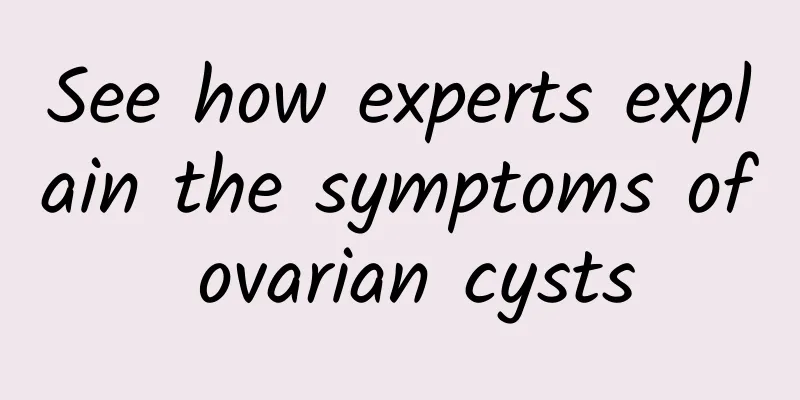See how experts explain the symptoms of ovarian cysts

|
"What are the symptoms of ovarian cysts?" Many people must have this question. Ovarian cysts are a common disease. Now, let the experts introduce the symptoms of ovarian cysts to you. I hope it can help you better understand the symptoms of ovarian cysts . 1. Symptoms of ovarian cysts include lower abdominal discomfort, which is the initial symptom before the patient feels a lower abdominal mass. Due to the weight of the tumor itself and the influence of intestinal peristalsis and body position changes, the tumor moves in the pelvic cavity, involving its pedicle and pelvic funnel ligament, causing the patient to feel fullness and falling in the lower abdomen or iliac fossa. 2. Increased abdominal circumference and abdominal mass are the most common symptoms. The patient feels that her clothes or belt are too tight, and she has just noticed the enlargement of her abdomen, or she feels it by chance in the morning, so she presses her abdomen and finds a mass in her abdomen, plus abdominal distension and discomfort. These are the symptoms of ovarian cysts. 3. Abdominal pain If the tumor has no complications, there is very little pain. Therefore, if patients with ovarian tumors feel abdominal pain, especially if it occurs suddenly, it is mostly due to the twisting of the tumor pedicle, or occasionally due to tumor rupture, bleeding or infection, which is also a symptom of ovarian cysts. In addition, malignant cysts often cause abdominal pain and leg pain, and the pain often causes patients to seek emergency treatment. 4. Menstrual disorders Ovarian cysts, even bilateral ovarian cysts, usually do not cause menstrual disorders because they do not destroy all normal ovarian tissues. Some uterine bleeding is not endocrine, but may be caused by ovarian tumors that change the pelvic blood vessels, causing endometrial congestion; or by ovarian malignant tumors that directly metastasize to the endometrium. Menstrual disorders caused by endocrine tumors are often combined with other secretory effects. 5. Compression symptoms Huge ovarian tumors can cause dyspnea and palpitations due to compression of the diaphragm. Ovarian tumors combined with large amounts of ascites can also cause such symptoms. However, some ovarian tumor patients have dyspnea due to unilateral or bilateral pleural effusions. And often combined with ascites, forming the so-called Meigs syndrome, which is also a symptom of ovarian cysts. Through the above introduction, everyone should have a better understanding of the symptoms of ovarian cysts. I hope everyone can get rid of the pain caused by ovarian cysts as soon as possible, and welcome everyone to continue to consult experts for more knowledge. |
<<: Help everyone understand the common treatment methods for irregular menstruation
>>: What are the main aspects of the examination of ovarian cysts?
Recommend
Are fasting and quitting sugar really effective for weight loss? 6 tips to lose weight when eating out! Nutritionist: Losing weight with these exercises is even better
There are hundreds of ways to lose weight. If you...
Staying up late for a week and gaining 2 kg, I’m so disgusted! 2 secrets for night owls to eat late night snacks without gaining weight
The FIFA World Cup in Russia has begun. Muscular ...
Is eating breakfast really harmful to your health? You should listen to your body.
There is an old saying: "A day's plan be...
What to do if threatened abortion recurs after recovery
Being pregnant is a very happy thing, but due to ...
What do cervical warts look like?
Do you know what cervical warts look like? Cervic...
There are several points to note for candidal vaginitis
What are the precautions for candidal vaginitis? ...
Ordering expert! Eat out carefully and avoid consuming too much oil
The number of people eating out is increasing. Lo...
Does uterine fibroids require surgery? Does uterine fibroids require surgery?
Some women with uterine fibroids tend to panic af...
A powerful tool for quickly losing visceral fat! Protein-lipid diet: Lose 14 kg in 1 year
The "Protein-Lipid Diet" that can elimi...
Is abortion anesthesia harmful to the body? Comparison of the degree of harm of the two types of abortion anesthesia
There are two main types of anesthesia for aborti...
Obesity is caused by eating. Nutritionists teach you how to lose weight without burden
Nurse Huang's weight loss journey (76 kg befo...
Does endometriosis affect life expectancy?
Nowadays, endometriosis has become one of the mos...
Diagnosis of premature menopause
We must actively grasp the diagnosis and differen...
How big should uterine fibroids be removed?
If women suffer from uterine fibroids, it will ha...
Breakfast cereal + juice may cause blood sugar fluctuations and may make you fat
Cereals are a quick and convenient breakfast choi...









